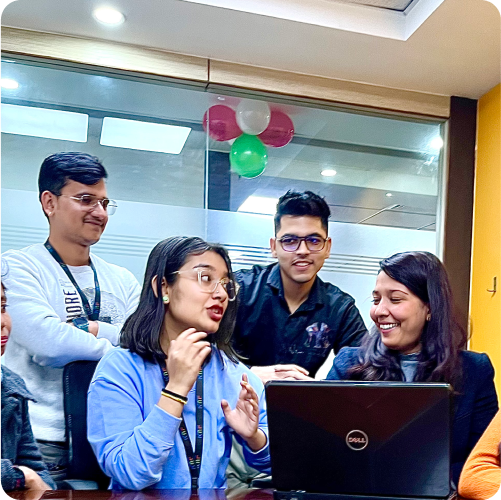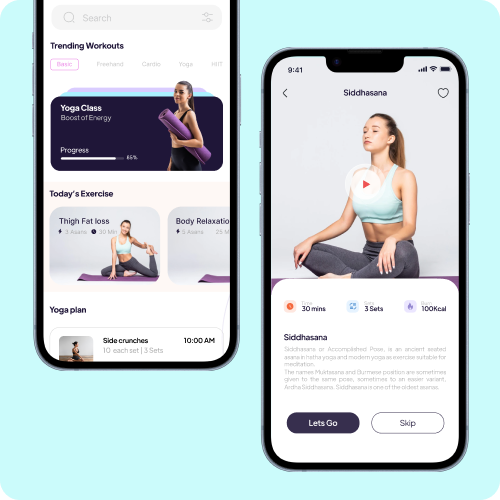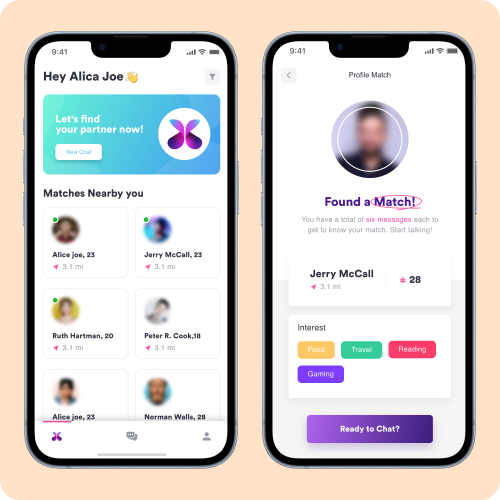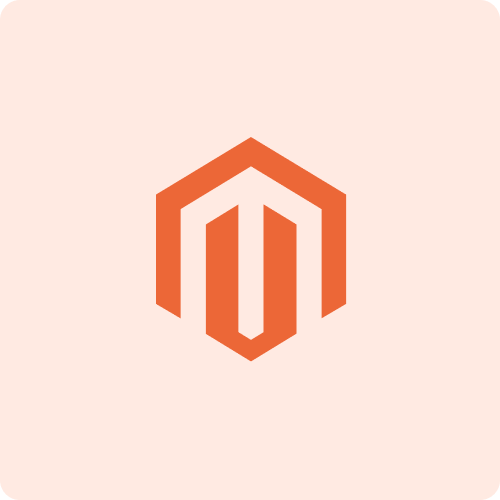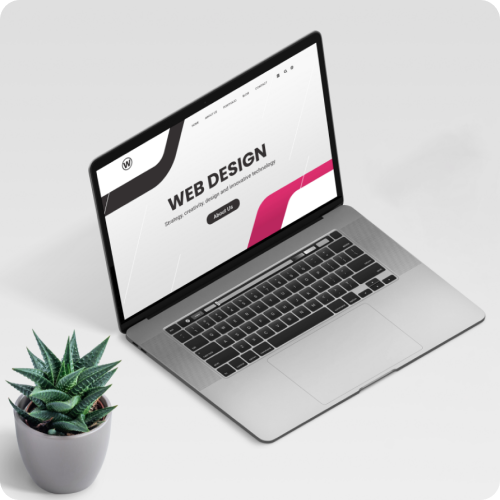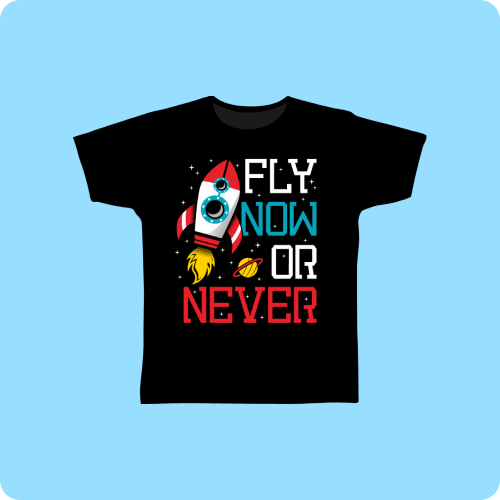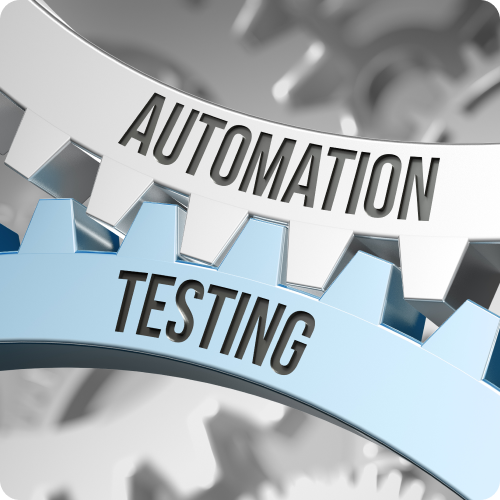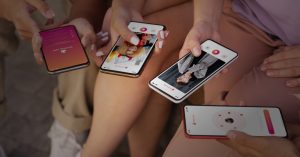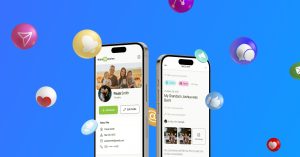Have you ever walked into something unprepared? Either the anxiety of that situation transforms into eustress rather than distress and you end up right back on your feet. Or you end up not operating that well at all and go all over the place. In the case of an MVP, you need to test your product before you acquire customers for your MVP. This blog is going to elaborate on how to test MVP along with a few examples of successful MVPs.
Brownie Points: As a bonus, you also get to download a minimum viable product MVP template!
FREE Bonus Material: Download Your FREE MVP Template
There is a reason why prototyping your product helps you in testing it before the big launch. Now you know exactly how your product functions when it is live!
Similarly, a minimum viable product (MVP) will help you test the waters before you deep dive into it to secure a better landing.
This is what the process must look like:
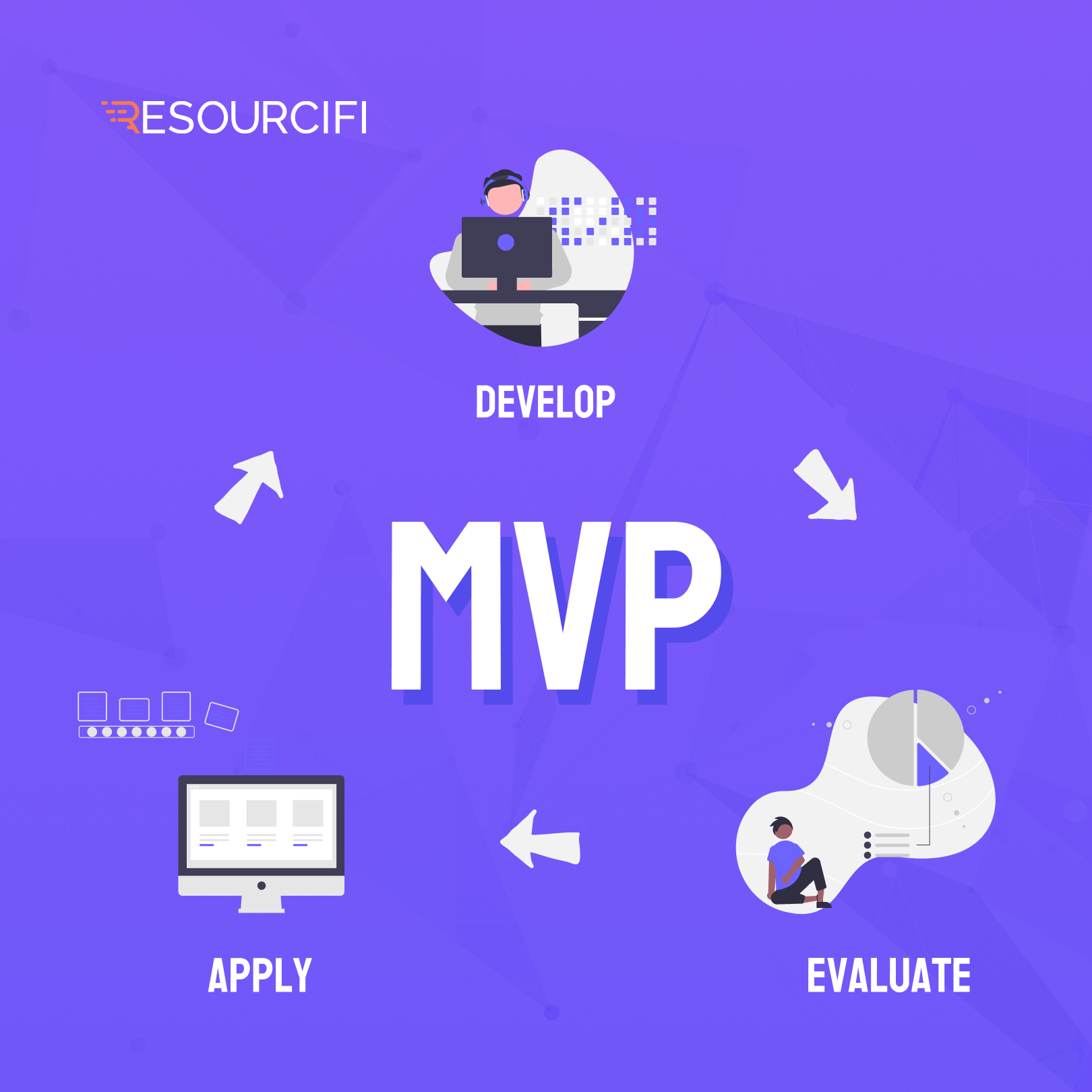
The aim here is to engage your target audience, improve your product offering, and capture quick feedback on your product. Only building an MVP is not enough, how to plan an MVP is just as important. Make sure that you also test your MVP and validate all of its key premises.
This will ensure that your MVP technique can meet the user requirements and the quality standards that you deliver. So without further ado, let’s hop onto how to test MVP and know what product testing for money is like!
There are several strategies of MVP testing methods and these will tell you exactly how to measure MVP success.
Here are the 8 minimum viable product checklists to make your MVP launch strategy a grand success! The minimum viable product MVP template will give you a framework to execute these MVP testing methods and also help you understand how to test MVP!
1. Customer Interviews
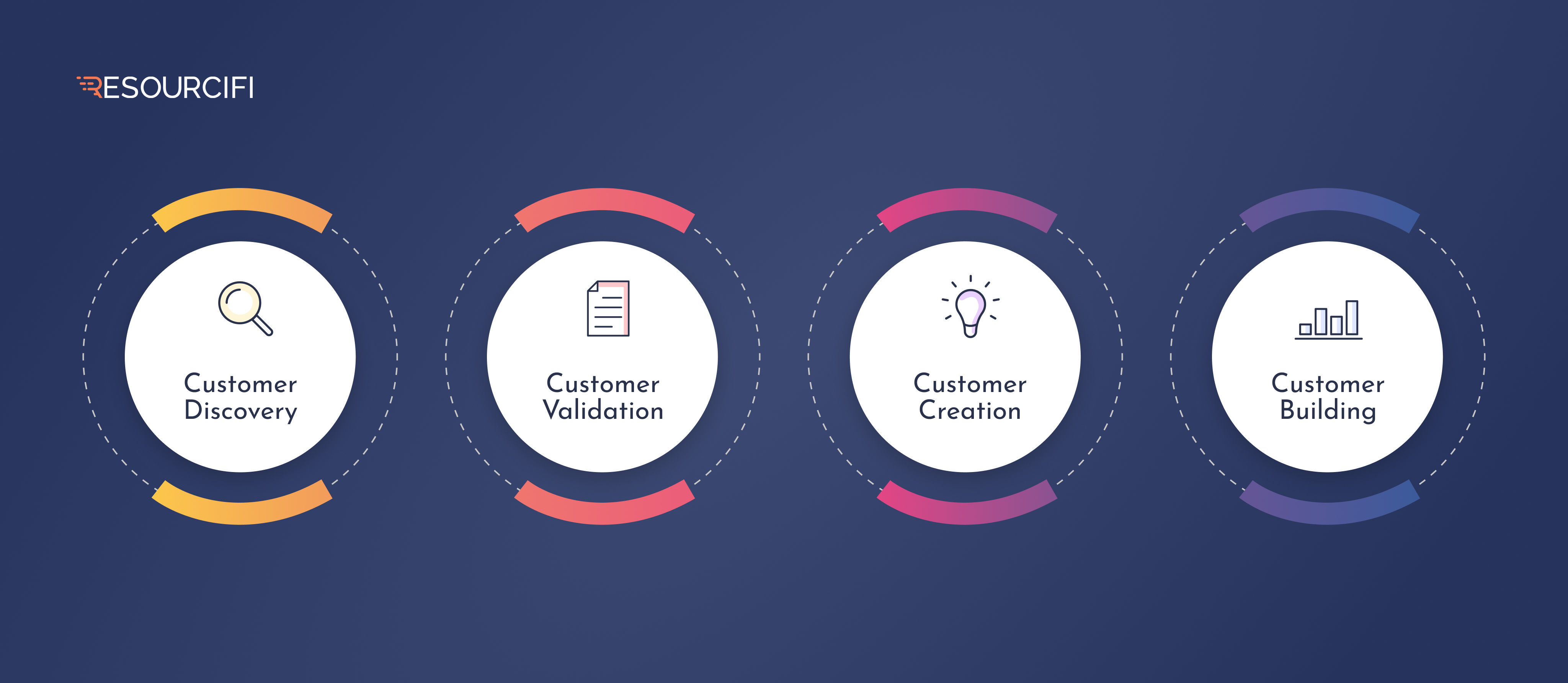
Every MVP entrepreneur is eager to know how to test products for money. Or to test his business hypothesis by getting acquainted with the target audience.
Customer interviews help you hit the goldmine when it comes to gathering insights from your customers. You get to know the problem your product intends to solve from your customers which would otherwise be impossible to collect. The goal here is to explain the value of your product rather than pitching your product for sales.
Ask them for their feedback on the solution that your product provides to all of the targeted problem statements. Rank the issues you are tackling is the best way to validate your MVP success metric.
These metrics help you understand user psychology and gather a database of your user’s persona based on your market research. In conclusion, you can now find the MVP proposal that makes your product testing opportunities worthwhile.
Besides interviews, you can conduct an online survey to ask customers whether your product is solving the customer’s problems. Assess what their ideal product features or improvements should be as an initial kick-start to your product tester.
“As the Minimal Viable Product is not the final version of your product, it mostly will not be perfect. Therefore, it is important to fix the bugs and major issues once the testing detects them.”
- Our experts at Resourcifi.
Make sure you encourage unfiltered and unrestricted responses about your MVP as a crucial component of your product testing techniques. There are probable chances that the targeted problem statement is not as crucial to the customer as you might have thought. This information helps you reshape your MVP to a viable final product.
2. Explainer Videos
Would you prefer a long boring PDF about an MVP product or a short and crisp video? A video that gives you the gist of what you need to know! If you get a detailed video relevant to what you need to know, then there is nothing like it.
An image may be worth a thousand words but a video is definitely worth a million!
It is much easier to give your customers the best showcase of what your product is all about. It shows them how it operates, what problems is the product helping you solve, and the entirety of this purposeful existence.
Leverage the exposure of the knowledge you are providing to your customers through the video. Leave them with enough information at hand to make an informed decision about your product. The number of sign-ups and inquiries will help you get an estimate of how many people have an interest in what your product has to offer.
It is always preferred to provide them with video content so that you can showcase the intended functionality of your product. Reach a larger audience and make a more persuasive stance with your insights offered in the video.
Here’s an inspiring story of how video content increased the number of signups. The fact that video appears in over 70% of the top SERP, accounts for 64-85% more people to buy after watching a product video. This is the best marketing strategy that you cannot afford to lose out on!
The most famous example of explainer videos is how Dropbox capitalized on it. Spending $50,000 for a 120-second video led to massive acquisition of 10 million customers making over $25 Million in revenue!
One of the best MVP testing examples is the organizational housewares of e-tailer StacksAndStacks.com reporting that most of the visitors were 144% more likely to purchase after they saw a product video as compared to those who did not provide them with any compelling video as a conversion lift.
It makes a greater impact when you walk your customers through a journey before they decide whether to sign up or not.
3. Experimental MVP Testing
The best way to know whether your MVP metric is covering what you wanted it to solve is by experimental testing. As a result, this type of testing attracts your target audience and helps you in assessing the interest of your idea if you set your mind on it.
Just like A/B testing in emails, you get to decide whether investing in your product was worth it or not. Define your hypothesis and design your experiment, and choose and execute the MVP experiment. Iterate and re-test your MVP even after failing at times.
FREE Bonus Material: Download Your FREE MVP Template
There are many great examples of successful MVP testing such as Amazon, Dropbox, Airbnb, Facebook, etc that are the best products!
Dropbox used Piecemeal MVP Testing, wherein they put up a 3-minute demo video of the product rather than building anything from scratch. The number of signups increased by 5 times overnight. What’s surprising is that without an actual product out there, the video was enough to sell the idea!
By putting together a functional demo of your product using the tools available. You can test the concept to assess whether people are willing to pay for the solution that you have come up with.
4. Manual-first MVPs
Manual-first MVP is also known as Wizard of Oz. It is another efficient MVP testing technique through which users can put up the impression of the complete product/service.
The product/service is delivered based on the user’s order. The user gets what their desired product/service is and they believe that they have acquired the entire experience of the full product. However, the real work is manually done behind the scenes.
It is also known as the flintstone MVP model which is to act as if your product already exists when in actuality, it is still in the development stage. This type of testing is ideal for many types of service-based startups.
One of the pioneers in Zappos online shoe retailing business is one of the classic examples of how successful this MVP technique can be.
Manual-first MVP testing requires lesser investment from your end but will help you test your MVP on many levels unlike any other. Through this, you can validate the set assumptions you carried about your MVP and test whether your product can solve customers’ problems or not.
5. Concierge MVPs
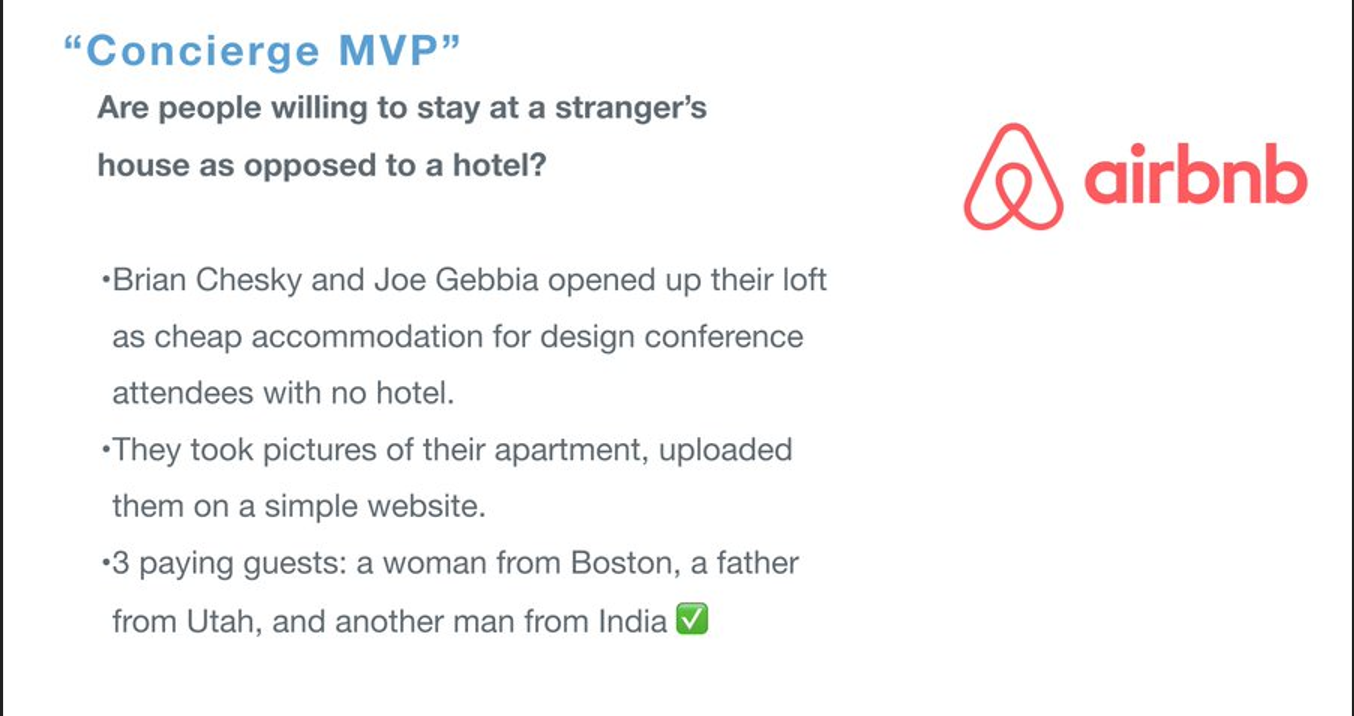
You must provide users with a genuine product/service that provides them with a highly customized experience. You can use this to validate your assumptions and check whether people would pay for your products or services.
Moreover, this type of MVP testing tries to find people who might want to try out a subscription service, like the Netflix app. This service would send them a personalized selection of features of the very product or the service.
If the idea proves to be successful, you can finally start to build an app that is based on the preferences of user response. As a result, you can choose what product to send to each person.
For example, many dress rental businesses such as Rent the Runway uses this Concierge MVP testing. They conducted their brand testing with the concierge MVP approach. They started by providing in-person service to all the college students to try a dress before they purchase it.
This increased their word-of-mouth marketing about their brand and tested their hypothesis. Furthermore, this approach helps in answering critical questions as to whether you are building a product that people want to buy.
6. Digital Prototyping
To do the most practical testing of your MVP, firstly, start by creating mock-ups, wireframes, and other prototypes of your products. Due to this, you will be able to assess how your product will function in a real-life setting. This helps in giving a clear demonstration to your potential customers. Secondly, validate their user experience, and find loopholes in your customer’s journey by testing your product!
Thirdly, be as creative as you can be with your prototypes. And most importantly, try to use applications that replicate the user experience of your product.
7. Paper Prototyping
Want to prepare and execute a simpler MVP testing method? Then Paper prototyping is your hero! You will not always require fancy tools and high-end systems to execute your ideas to test the waters before it goes live. This is why you can start with something as basic as a rough sketch of your work.
This type of prototyping not only helps in reducing the cost of your MVP testing but also helps in letting you flush out the bad ideas on a paper. Accelerate your brainstorming and ideation stage to determine the right path to take with your digital prototype.
It is an easier way of conceptualizing your MVP features. This helps in demonstrating user flow and functionality at an early ideation stage.
You can obtain your client and stakeholder buy-in before you begin your full-fledged work on a high-fidelity prototype.
8. Single-feature MVPs
Not only do Single-feature MVPs reduce your development time drastically but also help in narrowing down your customer base. Most importantly, you get to focus on a single main feature during MVP testing rather than testing all of the features at once.
Start by letting users test simple features that do not require too much additional testing and effort.
This type of testing helps to check market viability and understand what to maintain on MVP as long as you are testing it out and narrowing down your tasks to focus on running app tests.
By developing a website version and checking support integration on numerous mobile platforms, you start to choose focus rather than distraction!
Now that you know how to test MVP, here are a few minimum-viable product examples that should give you some great insights!
Minimum Viable Product Examples
1. Facebook
Facebook initially started off as Facemash – a website that had pictures of every student in the university. Built by Mark Zuckerberg and his classmates Andrew McCollum, Chris Hughes, and Dustin Moskovitz during their time at Harvard University, the site was brought down by the Harvard executive due to certain violations of privacy.
However, later the website went on to be sold for $30,201 in acquisition. Finally, in January 2004, the world witnessed the start of what is now known today as Facebook. Back then it was called Thefacebook which severely lacked the features that it has today.
Before:
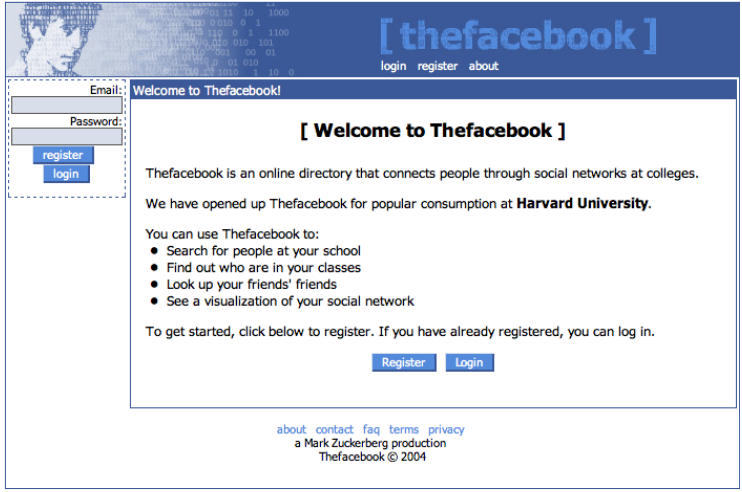
The original homepage of Thefacebook.
It was initially created as an application that was restricted to only Harvard and then expanded on to include the top three other American Universities as a universal directory. By 2005, it was renamed Facebook which we know today.
After:

From 26th September 2006, it was accessible to everyone with a valid email address for 13+ or above.
Key success of the MVP:
Zuckerberg has built a very basic model of the product that only required functionality to reach its goal. It was earlier realized to a very small group of users to test the application and gain feedback.
Facebook is now at 1st rank of the world’s most active social media platforms, having 2.936 billion monthly active users in April 2022.
Facebook’s monthly active users equate to 37.0% of all the people on Earth today. To put that in perspective, Facebook’s active user base is now larger than the total populations of China and India combined.
2. Twitter
Originally known as ‘twttr’, this social network came up with the invention of what social media geeks religiously use – #hashtag. Four board members back in March 2006, Jack Dorsey, Evan Williams, Biz Stone, and Noah Glass of Odeo (Podcast company), developed an SMS service that would allow users to interact with a small group of people.
Starting off as a prototype designed for internal users of Odeo as a medium to send messages to employees and view them in groups, Twitter was finally released on July 15, 2006.
Before:
It took its flight after it was featured at a Southwest Interactive Conference in 2007. This shoutout increased its user base rapidly and its popularity boomed and flourished ever since!
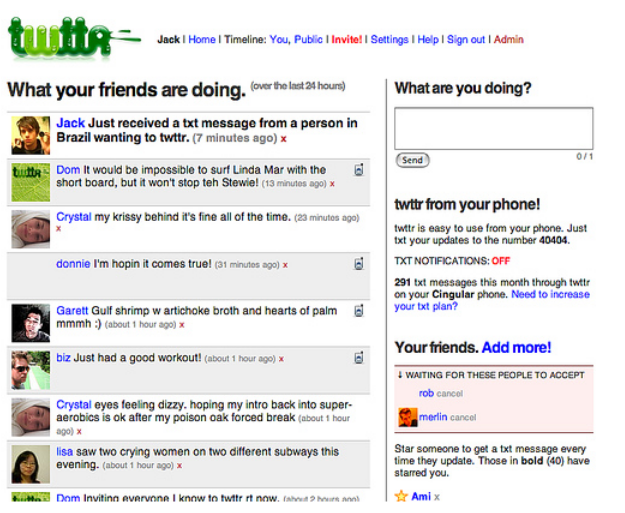
twttr’s first homepage MVP
It went public on 7th November, and as a result, it could bag a huge market capitalization of about $26.46 billion and a major price jump.
Key Success of the MVP:
Twitter much like Facebook was also released to a small set of people for user testing and gaining feedback. Since all of the features were not overloaded in the first few releases which allow it to stick to its initial goal of testing.
After:

Twitter’s user count is expected to grow upwards of 329 million in 2022. Twitter is the second most popular social media platform in the world with majorly of its users between the age range of 16-64.
3. Zappos
One of the greatest examples of a successful MVPS is Zappos – an online retail store for clothes, shoes, handbags, accessories, etc. However, initially, the company focused on selling shoes.
Going to the shops could be very frustrating and time-consuming. The founder had just the same experience which he later turned into a billion-dollar e-commerce company. His primary goal was to test whether people would purchase shoes online.
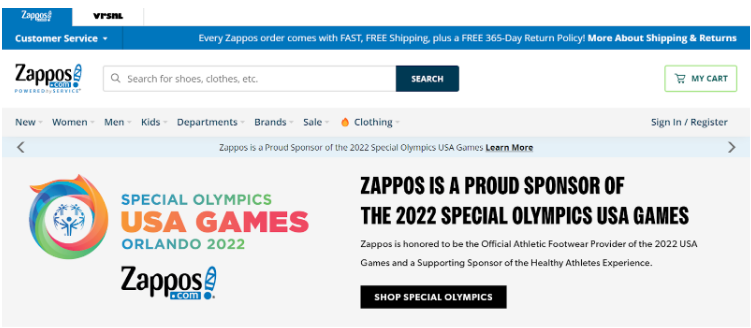
To validate his ideas, the CEO of Zappos, Nick Swinmurn, took photos of shoes in all different stores. Then he uploaded them on a simple idea to test whether the idea would take off.
When any user clicked to buy a pair of shoes, Nick would purchase that pair from the local store and ship it. This grew its customer base tremendously as they loved this idea and he received more orders from them.
FREE Bonus Material: Download Your FREE MVP Template
Key Success of the MVP:
His steps to validate his idea were simple – building more features and expanding his product range.
Building a very effective website that showcased the idea to the users as a way to interact with the business.
Testing the assumptions by ensuring whether a market for the business existed before letting the product test waters.
Known as the number one e-commerce shop store in the US. Currently, its estimated annual revenue is more than $2B. Zappos.com’s estimated annual revenue is currently $600.3M per year (source)
3. Spotify
Spotify is another such successful MVP example with only one unique feature that gave it an upper hand.
Back in the days when buying CDs or paying for an album on iTunes was highly expensive, Spotify launched a website that had a cheap monthly subscription for music streaming. This later became the utopia for music lovers!
The founders broadened their music services after having meetings with different music labels. After its initial rise in engagement rate with the early adopters, the customers were hooked on Spotify.
In March 2022, Spotify had a market cap of $23.88 billion. In the first quarter of 2022, music streaming service Spotify reported 422 million active users worldwide. This marked an increase of over 60 million in just one year.
Final Words
You do not have to always worry about the perfect MVP launch strategy. Instead, ensure to test your products before acquiring customers and get feedback for MVP testing.
Having the first market test of your app idea gives you an ample amount of opportunity to create a successful product/app. Test your MVP ideas by using the minimum viable product MVP template to measure your product’s success!
We, at Resourcifi, are an award-winning Staff Augmentation company. Helping businesses create impressive products, hire our highly-skilled web and mobile app developers on a part-time, full-time, or hourly basis. Read this guide on how to hire remote developers for your project.
Frequently Asked Questions:
What is MVP testing?
MVP testing allows businesses to test a product idea and assess the validity or invalidity of their business plan. But the challenge always is to understand how to test MVP since the idea here is to create a usable prototype of the product (essentially a beta version). Although, you can release the unfinished version to prospective users after the testing.
How do you test your MVP?
Let’s sum up how to test MVP! There are several tactics for testing minimum viable product:
- Fundraising
- Blogs
- Customer interviews
- Videos
- Pre-order Pages
- Social-media online surveys
- Paper prototypes
- Emailing
- Landing Pages
- A/B Testing
- Piecemeal MVPs
- PPC Campaigns
- Micro-Surveys
- Ad Campaigns
- Services and Platforms
- Manual-first MVP
- Concierge MVPs
- Digital Prototypes
- Single Feature MVP
- Software testing
How do you measure MVP?
Knowing how to test MVP is a necessity but that cannot go on without measuring it. Measuring MVP can be a tricky task because of which you must follow these recommended steps to measure your MVP:
- Download and launch rate of your MVP
- User ratings and store placement
- Customer acquisition cost (CAC)
- Percentage of active users
- Percentage of paying users
- Divide the monthly average revenue per user (ARPU) is revenue from in-app purchases by the number of active users
- Customer lifetime value (CLV)
- Churn = Number of churns per week (month) / Number of users at the beginning of the week (month)
How to validate your MVP?
How to test MVP is just as important as how to validate your MVP. A crucial and foundational aspect of MVP validation is an open form of communication between product teams and the market. A few of these methods of two-way communication have proven as effective in our modern age as blogs.
Blogs not only allow you to validate your ideas. You can now choose to narrow down your target market and gauge their response.
The MVP of any new business should be tested by whom?
Now that you know how to test MVP. Also, understand that conducting validation testing is an important part of the MVP process. The beta testers need to focus on giving valuable feedback on the user interface. They try to experience if there are no major functional bugs.



